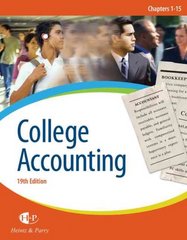Question
Case 7-1 The Greater Providence Deposit & Trust Embezzlement Nino Moscardi, president of Greater Providence Deposit & Trust (GPD&T), received an anonymous note in his
Case 7-1 The Greater Providence Deposit & Trust Embezzlement
Nino Moscardi, president of Greater Providence Deposit & Trust (GPD&T), received an anonymous note in his mail stating that a bank employee was making bogus loans. Moscardi asked the banks internal auditors to investigate the transactions detailed in the note. The investigation led to James Guisti, manager of a North Providence branch office and a trusted 14-year employee who had once worked as one of the banks internal auditors. Guisti was charged with embezzling $1.83 million from the bank using 67 phony loans taken out over a three-year period.
Court documents revealed that the bogus loans were 90-day notes requiring no collateral and ranging in amount from $10,000 to $63,500. Guisti originated the loans; when each one matured, he would take out a new loan, or rewrite the old one, to pay the principal and interest due. Some loans had been rewritten five or six times.
The 67 loans were taken out by Guisti in five names, including his wifes maiden name, his fathers name, and the names of two friends. These people denied receiving stolen funds or knowing anything about the embezzlement. The fifth name was James Vanesse, who police said did not exist. The Social Security number on Vanesses loan application was issued to a female, and the phone number belonged to a North Providence auto dealer.
Lucy Fraioli, a customer service representative who cosigned the checks, said Guisti was her supervisor and she thought nothing was wrong with the checks, though she did not know any of the people. Marcia Perfetto, head teller, told police she cashed checks for Guisti made out to four of the five persons. Asked whether she gave the money to Guisti when he gave her checks to cash, she answered, Not all of the time, though she could not recall ever having given the money directly to any of the four, whom she did not know.
Guisti was authorized to make consumer loans up to a certain dollar limit without loan committee approvals, which is a standard industry practice. Guistis original lending limit was $10,000, the amount of his first fraudulent loan. The dollar limit was later increased to $15,000 and then increased again to $25,000. Some of the loans, including the one for $63,500, far exceeded his lending limit. In addition, all loan applications should have been accompanied by the applicants credit history report, purchased from an independent credit rating firm. The loan taken out in the fictitious name would not have had a credit report and should have been flagged by a loan review clerk at the banks headquarters.
News reports raised questions about why the fraud was not detected earlier. State regulators and the banks internal auditors failed to detect the fraud. Several reasons were given for the failure to find the fraud earlier. First, in checking for bad loans, bank auditors do not examine all loans and generally focus on loans much larger than the ones in question. Second, Greater Providence had recently dropped its computer services arrangement with a local bank in favor of an out-of-state bank. This changeover may have reduced the effectiveness of the banks control procedures. Third, the banks loan review clerks were rotated frequently, making follow-up on questionable loans more difficult.
Guisti was a frequent gambler and used the embezzled money to pay gambling debts. The banks losses totaled $624,000, which was less than the $1.83 million in bogus loans, because Guisti used a portion of the borrowed money to repay loans as they came due. The banks bonding company covered the loss.
The bank experienced other adverse publicity prior to the frauds discovery. First, the bank was fined $50,000 after pleading guilty to failure to report cash transactions exceeding $10,000, which is a felony. Second, bank owners took the bank private after a lengthy public battle with the State Attorney General, who alleged that the bank inflated its assets and overestimated its capital surplus to make its balance sheet look stronger. The bank denied this charge.
1. How did Guisti commit the fraud, conceal it, and convert the fraudulent actions to personal gain?
2. Good internal controls require that the custody, recording, and authorization functions be separated. Explain which of those functions Guisti had and how the failure to segregate them facilitated the fraud.
3. Identify the preventive, detective, and corrective controls at GPD&T, and discuss whether they were effective.
4. Explain the pressures, opportunities, and rationalizations that were present in the Guisti fraud.
5. Discuss how Greater Providence Deposit & Trust might improve its control procedures over the disbursement of loan funds to minimize the risk of this type of fraud. In what way does this case indicate a lack of proper segregation of duties?
6. Discuss how Greater Providence might improve its loan review procedures at bank headquarters to minimize its fraud risk. Was it a good idea to rotate the assignments of loan review clerks? Why or why not?
7. Discuss whether Greater Providences auditors should have been able to detect this fraud.
Step by Step Solution
There are 3 Steps involved in it
Step: 1

Get Instant Access to Expert-Tailored Solutions
See step-by-step solutions with expert insights and AI powered tools for academic success
Step: 2

Step: 3

Ace Your Homework with AI
Get the answers you need in no time with our AI-driven, step-by-step assistance
Get Started


